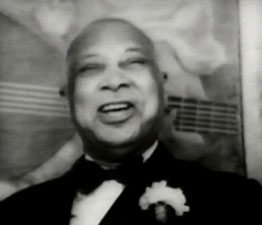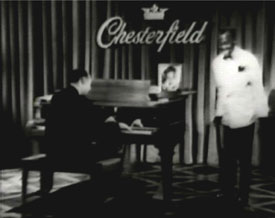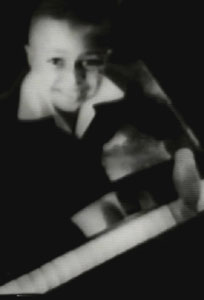A shockingly bad documentary A shockingly bad documentary The Negro in Entertainment (1950) alleges to show African American entertainers of the era as selected by a "national board of selection" made up of such men as Frederick D. Patterson, president of the Tuskegee Institute; Reverand Marshal Shepherd of Philadelphia; William J. Trent, Jr., of the United Negro College Fund; Bill Lund the managing editor of the Pittsburgh Courier, & Claude A. Barnett of the Associated Negro Press.
 The short film was funded by Chesterfield cigarettes, & throughout the viewer is cajoled to smoke Chesterfields to show the race's slavish gratitude for this documentary. The short film was funded by Chesterfield cigarettes, & throughout the viewer is cajoled to smoke Chesterfields to show the race's slavish gratitude for this documentary.
I'm sure at least some of the people who lent their names to this film, real leaders in the community, made their concessions to Chesterfield innocently enough, in a day when fewer people even questioned Caucasion-profitting industries' desire to sell booze, cigarettes, & illicitely even hard drugs, to African Americans, siphoning funds out of the community by offering in exchange addiction, ill health & early death.
But to give the Chesterfield manufacturers their due, they were equal opportunity when it came to pitching cigarettes. They sponsored many live concerts, radio shows, & early television varietie pkrograms that were integrated at a time when integration was still illegal in many places; & regularly hired African American spokespersons from the sports & entertainment world. They were as progressive as vendors of cancer could ever be.
What they doubtless hoped they were doing was the hard work of the "racial uplift movement," a movement which put a high priority on black folks' capacity to embrace & emulate European culture. This uplift movement would undergo refinements over time & was one of the earliest ideologies to empasize Pride for all African Americans.
There were giants of the Harlem Renaissance who knew exactly how great & important jazz happened to be. But sometimes, & especially in cities less sophisticated than New York & among the class-consciousness of many an uplift leader, there was an issue resembling that of a small black child preferring a white doll to a black doll because the whtie doll somehow conveyed status, prettiness, & arpeferability. There there was for many within the uplift movement who preferred arts that did not originate among black people, a dislike of tapdancers in preference for ballet dancers, for instance.
Ideology encouraged a reluctant respect for jazz, a music form that came right out of black America, as opposed to classical European composers. A well-trained singer who might bring a little but not too much of an African American sensibility into the realm of the European classics would be uplifting, whereas a sexy hot jazz performer at the Savoy was neither artistically nor morally respectable.
 So any tedium that arises in this documentary is born in part from the notion that popular entertainers were the "wrong" ones from the perspective of racial uplift. So any tedium that arises in this documentary is born in part from the notion that popular entertainers were the "wrong" ones from the perspective of racial uplift.
It would be an exaggeration that the black middleclass reaching down to help their community were agreeing with white folks that jazz was the devil's music. But if they could promote ballet & opera over the greatest jazz musicians the world would ever know, they'd do so. Racial uplift attitudes survive today when middleclass & privileged blacks rail against hip-hoppers for saying "nigger" & reflecting the world as it exists rather than as a utopia, & in their inability to see rap as inclusive of the most vital & important modern poetry in America.
If the "board" exerted actual authority over the documentary content, it would explain the inclusion of Bill "Bojangles" Robinson for only a couple of seconds revealing next to nothing of his talent. In uplift movement of the '40s & '50s was a burgeoning sentiment that white folks like to see black folks tapdance therefore tapdance is demeaning.
So we glimpse Bill Robinson barely long enough to read the Chesterfield ad posted over his head. The ultra-brevity of the moving snapshot poorly balances respect for the successes of entertainers like Bill Robinson, with the uplift movement's own sense that black folk should be more interested than was ever likely in "higher" forms of dance.
A parade of exceedingly brief vignettes from a multitude of black entertainers does flutter by, many filmed underneath a sign for Chesterfields, while hosts Bill Lund & Claude A. Barnett smoke up a storm, & nearly silent Etta Moten Barnett sits with them around a table claiming to have stories she could tell about these great entertainers, though she tells none.
Some of these vignettes are excerpted from pre-existing archive footage or soundies or newsreels, but several seems to have been filmed just for this presentation, yet so abbreviated one wonders why they bothered to get new footage at all. So Ethel Waters sings two lines under a Chesterfield sign & that's that.
Some rare footage of Sugar Chile Robinson, a gifted child playing boogie piano, is a highlight moment. An all too brief glimpse of Una Mae Carlisle performing "It Ain't Like That" at her piano is excerpted from Boarding House Blues (1948). We get swift glimpses of Louis Armstrong, W. C. Handy, Fats Waller, Duke Ellington, but the amount of music sampled all told takes about thirty seconds for all of them combined.
Having made their halfhearted nod to stuff people actually like, the selecting team revealed their racial upleft preferences, giving far greater focus on some invited performances by classically trained baratone Lawrence Winters, who provides a stentorial rendition of "Song of the Open Road," as well as moments for the King's Choir conducted by John King, prima ballerina Janet Collins, & Metropolitan opera soprano Camilla Williams. It's great to see samples of all these, but amusing that the "political" slant preferred them.
And of course we're reminded by the intruding commentators sitting around their table smoking that "Many of these stars are Chesterfield smokers."
The combination of race pride & cigarette salesmanship is at times cloying & creepy, with most of the talents sampled so briefly that the cigarette ad ends up being a lot bigger part of it than the talent.
Less interesting & twice as stuffy are two companion films with similar structure. First is The Negro in Sports (1950) featuring clips of Jackie Robinson, Mary McNabb, Willie Mays, the Harlem Globetrotters, & a great many others, some of whom, like Jackie, were Chesterfields spokespersons. The great Jesse Owens narrates, while host Bill Lund extoles all black people to smoke Chesterfields. Sportsmen do, & so should you.
Similarly, The Negro in Industry (1952) once more pitches cigarettes while showing African Americans of achievement, from Horace Sudduth of the National Negro Business League to Congressman William Dawson of Illinois, with some homage to the common laborer worked in as they're such great smokers. These latter two films draw on newsreel footage from All American News company.
All three of these one-reel docmentaries are in circulation in 16 mm film prints, & are included in the video tape compilation Rare Black Short Subjects: The Negro in Industry, Sports & Entertainment (1996), together with an additional half-hour of related material: a film about Franklin Roosevelt's valet; about physical fitness at Tuskegee; labour issues; & others.
copyright © by Paghat the Ratgirl
|

 The short film was funded by Chesterfield cigarettes, & throughout the viewer is cajoled to smoke Chesterfields to show the race's slavish gratitude for this documentary.
The short film was funded by Chesterfield cigarettes, & throughout the viewer is cajoled to smoke Chesterfields to show the race's slavish gratitude for this documentary. So any tedium that arises in this documentary is born in part from the notion that popular entertainers were the "wrong" ones from the perspective of racial uplift.
So any tedium that arises in this documentary is born in part from the notion that popular entertainers were the "wrong" ones from the perspective of racial uplift.